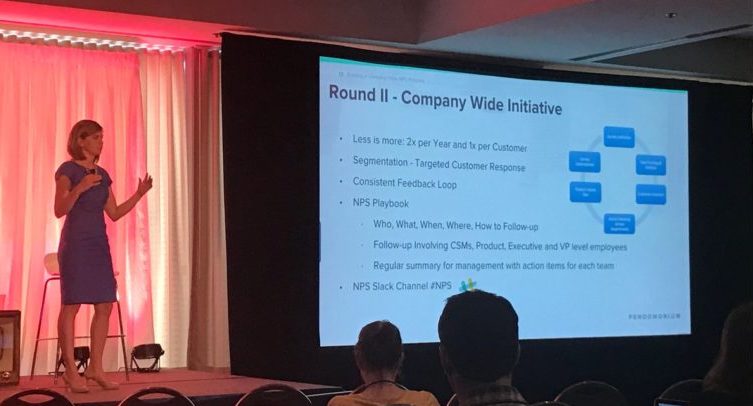As a company grows, it’s important to establish a baseline for customer loyalty. Invoca, a call tracking and analytics company, was trying to do just that when they implemented their NPS program.
They were able to not only establish that baseline, but also understand and predict product retention, identify areas for product improvement, and expose all employees to the customer voice.
However, as many companies discover, determining the best segmentation and cadence for NPS is not always easy. In fact, Invoca released three iterations of their NPS program before determining the best practices they use today.
Amy Andriano, Invoca’s customer experience manager, shared her takeaways and learnings from building their NPS program during Pendomonium 2017.
During her presentation, Amy discussed six factors that make up a successful NPS program.

1. Use Targeted Customer Segments
During the first round of NPS, Invoca experienced some data quality issues. There was no information on who received the survey, how often the survey was given, or on nonresponders. This resulted in an unreliable NPS score. In later rounds, Invoca was able to use Pendo to solve this problem by targeting who saw the survey. This enabled Invoca to collect data on customers who responded as well as those who didn’t. In addition, they were able to ensure randomization for customer segments and make sure the survey was not given multiple times to the same customer. This resulted in a better data set with more context and accuracy, and deeper insights into their customer scores.
2. Implement Company Goals
As Invoca worked on improving their NPS program, they realized the importance of having company goals. It helps to ask “Why are we collecting NPS?” There has to be a reason for collecting the data, or the results will not benefit the company. Before you start collecting data you need to solidify what your goals are as a company, what information you are trying to collect, and how you will use the data to improve your product.
3. Create an NPS Playbook
To line up with company goals, Invoca uses an NPS playbook. This playbook entails:
- A script of how to respond to customers
- A timeline on the follow ups
- How different teams are going to be interacting with the information
This ensures that everyone is involved in understanding the feedback and responding to customers.
4. Define Roles
After establishing a process and the time it takes to provide feedback, Invoca was able to assign two to three people to run the NPS program and follow up with user responses. They incorporated continuous deployment and enabled an effective communication loop by making sure everyone knew what needed to be done and who was going to do it. This allowed them to deal with NPS in a repeatable manner and kept their program organized.
5. Promote Company-Wide Involvement
Invoca uses Pendo’s Zapier integration to send poll responses to Slack, which allows them to easily distribute NPS scores in real time to their entire team. This allows them to keep NPS top of mind for the entire company. The CEO can jump in and comment on the scores which helps boost company morale, and keeps NPS relevant in the company on a day- to- day basis.
6. Know What Data is Needed
Invoca understood what data was needed to have both a well-rounded NPS program and a well-rounded NPS score. After implementing the NPS program, they received feedback regarding:
- Pricing
- Level of Effort
- Operational
- Innovation
- Training Resources
- Ease of Use
- Range of Services
- Relationship

Invoca was able to use Pendo to find specific data that would most benefit the company and help grow their product. The results from the NPS scores showed which features the company needed to prioritize, leverage, improve, or maintain in order to drive their product.
“NPS is an excellent tool to use while trying to understand where to take your product and understanding current customer satisfaction overall.” – Amy Andriano
Amy shares that if you work as a team to make your NPS program successful, it can become a useful tool in your “customer health” toolkit. She says, “Unfortunately this is not the end-all, be-all of customer satisfaction and customer happiness, but it’s definitely an excellent tool to use while trying to understand where to take your product and understanding current customer satisfaction overall.”
Watch Amy’s full presentation here.


